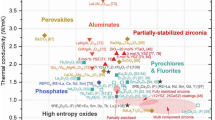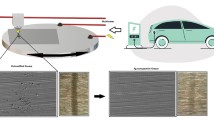Abstract
At present, the mechanism of metal impact polarization is still unclear. A new method for measuring the electric polarization characteristics of metal materials under impact load based on electromechanical theory have been proposed in this paper. The electromechanical response characteristics of 6061Al under different loading conditions, thicknesses and electrode parameters are studied using the split Hopkinson pressure bar (SHPB) system. Combining with the ANSYS/LS-DYNA numerical simulations corresponding to the experimental conditions, the strain gradients and electromechanical coefficients of 6061Al with different thicknesses and electrode geometric parameters are obtained. The results show that polarization voltages first increase then decrease with time, but their maximum value is first decreases then increases with the increasing of loading speed; the polarization voltages of 6061Al with cross-shaped electrode are larger than that with annular notched electrode or fully covered electrode; with the increasing of strain rate, the response times of the maximum polarization voltage time t(\({U_{{\text{Max}}}}\)) and the maximum strain ratio time t(\({\dot {\varepsilon }_{{\text{Max}}}}\)) are increased; the strain gradients decrease with the increasing of thickness but the polarization intensities tend to be opposite; the polarization intensities of 6061Al with fully covered electrodes and annular notch electrodes are close, however, the polarization intensities of 6060Al with cross-shaped electrode are larger; the electromechanical coefficients of 6061Al are about 10−2–101 C/m.








Similar content being viewed by others
Data availability
The datasets generated during and/or analysed during the current study are available from the corresponding author on reasonable request.
References
F.E. Allison, Shock-Induced polarization in Plastics. I. Theory. J. Appl. Phys. 36(7), 2111–2113 (1965)
M.H. Rice, R.G. Mcqueen, J.M. Walsh, Compression of solids by strong shock waves. Solid State Phys. 6, 1–63 (1958)
M. de Icaza Herrera, Phenomenological theory of shock-induced polarization. I Appl. Phys. 54, 2352 (1983)
M. de Icaza Herrera, Phenomenological theory of shock-induced polarization II mathematical treatment oscillogram. J. Appl. Phys. 54, 2360 (1983)
P. Harris, Mechanism for the shock polarization of Dielectrics. J. Appl. Phys. 36(3), 739–741 (1965)
R.A. Graham, Shock induced electrical activity in polymeric solids, a mechanically induced bond scission model. Appl. Phys. 49, 4186 (1978)
G.E. Hauver, Shock Induced polarization in Plastics. II. Experimental study of plexiglas and polystyrene. Appl. Phys. 36, 2113 (1965)
N.L. Coleburn, J.W. Forbes, H. Jones, D. Electrical measurements in silicon under shock-wave compression. Appl. Phys. 43, 5007 (1972)
P.C. Lysne, Dielectric properties of shock wave compressed PMMA and an aluminaloaded epoxy. Appl. Phys. 49, 4186 (1978)
G.P. Zhen, F.H. Chen, Impact polarization effect and application of layered PMMA. J. Beijing Univ. Technol. 02, 16–24 (1992)
Y. Huang, Strain-induced electric effect in metals. J. Mater. Sci. Applicat. 5(3), 58–62 (2019)
V.S. Mashkevich, K.B. Topygo, Electrical, optical and elastic properties of diamond type crystals. Sov. Phys. JETP 003, 435–439 (1957)
K.B. Topygo, Long wavelength oscillations of diamond-type crystals including long range forces. Sov. Phys.-Solid State 007, 1297–1305 (1963)
W. Ma, L.E. Cross, Observation of the electromechanical effect in relaxor pb(Mg1/3Nb2/3)O3 ceramics. Appl. Phys. Lett. 78(19), 2920–2921 (2001)
S.R. Kwon, W. Huang, L. Shu et al., Electromechanicality in barium strontium titanate thin film. Appl. Phys. Lett. 105(14), 2069 (2014)
T. Hu, Q. Deng, X. Liang et al., Measuring the electromechanical coefficient of bulk barium titanate from a shock wave experiment. J. Appl. Phys. 122(5), 055106 (2017)
T. Hu, Q. Deng, S. Shen, Probing electromechanicality via a split Hopkinson pressure bar experiment. Appl. Phys. Lett. 112(24), 242902.1–242902.5 (2018)
H. Zhu, L. Zhu, J.H. Chen, Effect of stress triaxiality and strain rate on mechanical properties of 6063 525 aluminum alloy and material characterization. J. Mater. Sci. Eng. 25, 526 (2007)
M. Cai, Y.D. Gong, N. Yu et al., Simulation and experimental study on milling force in micro scale milling of 6061 aluminum alloy. J. Northeast Univ. (2018). https://doi.org/10.12068/j.issn.1005-3026.2018.01.016
S.M. Kogan, Piezoelectric effect during inhomogeneous deformation and acoustic scattering of carriers in crystals. Sov Phys. Solid State. 5, 2069 (1964)
Acknowledgements
The authors gratefully acknowledge the financial support of the National Natural Science Foundation of China within the project with Grant No.12002220.
Funding
This work was supported by National Natural Science Foundation of China Grant No. 12002220.
Author information
Authors and Affiliations
Contributions
ET: conceptualization. PL: data curation, formal analysis. RW: investigation. MC: supervision. YH: methodology. CC: writing—original draft. KG: writing—review and editing. LH: validation.
Corresponding authors
Ethics declarations
Conflict of interest
The authors declare that they have no conflicts of interest.
Research involving human and animal participants
The main idea excluded state that in the research you observed humane principles, respected the welfare of animals, and situations when animals were in pain.
Additional information
Publisher’s Note
Springer nature remains neutral with regard to jurisdictional claims in published maps and institutional affiliations.
Rights and permissions
Springer Nature or its licensor (e.g. a society or other partner) holds exclusive rights to this article under a publishing agreement with the author(s) or other rightsholder(s); author self-archiving of the accepted manuscript version of this article is solely governed by the terms of such publishing agreement and applicable law.
About this article
Cite this article
Tang, E., Liu, P., Wang, R. et al. Polarization response characteristics of 6061Al under impact loading. J Mater Sci: Mater Electron 34, 1732 (2023). https://doi.org/10.1007/s10854-023-11135-w
Received:
Accepted:
Published:
DOI: https://doi.org/10.1007/s10854-023-11135-w




